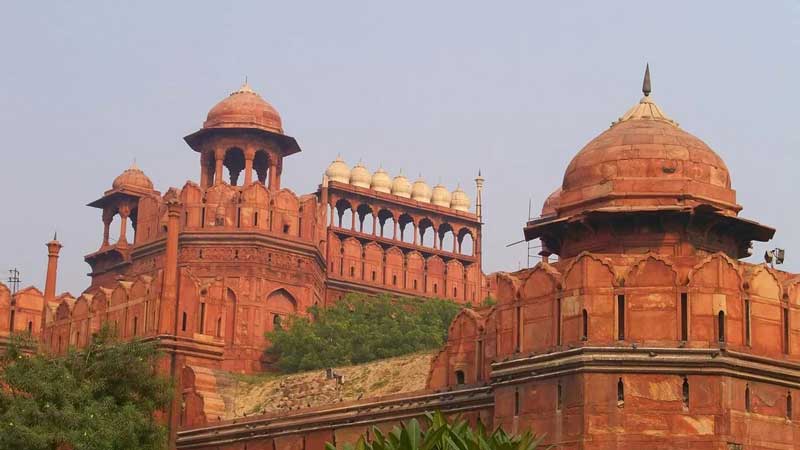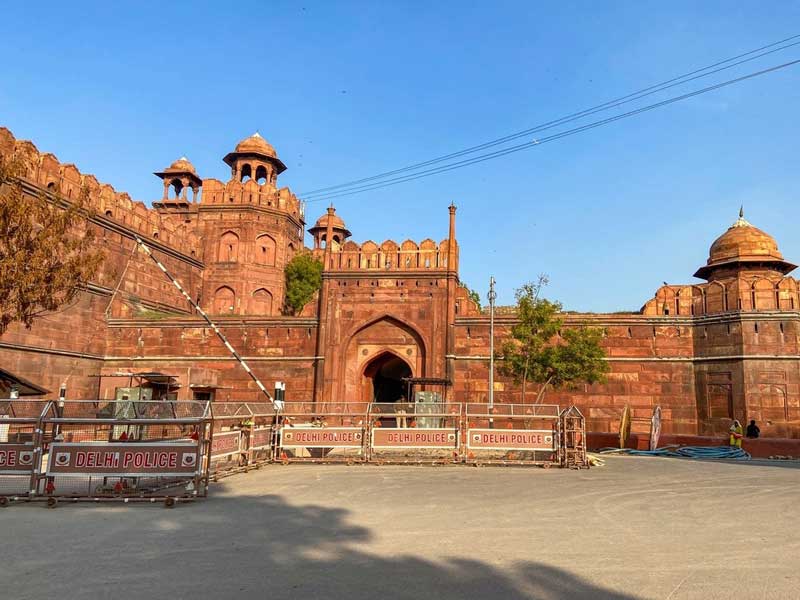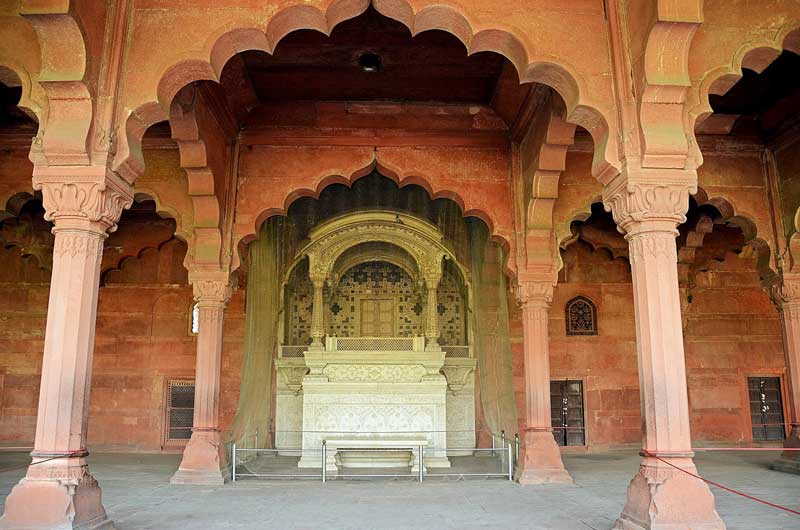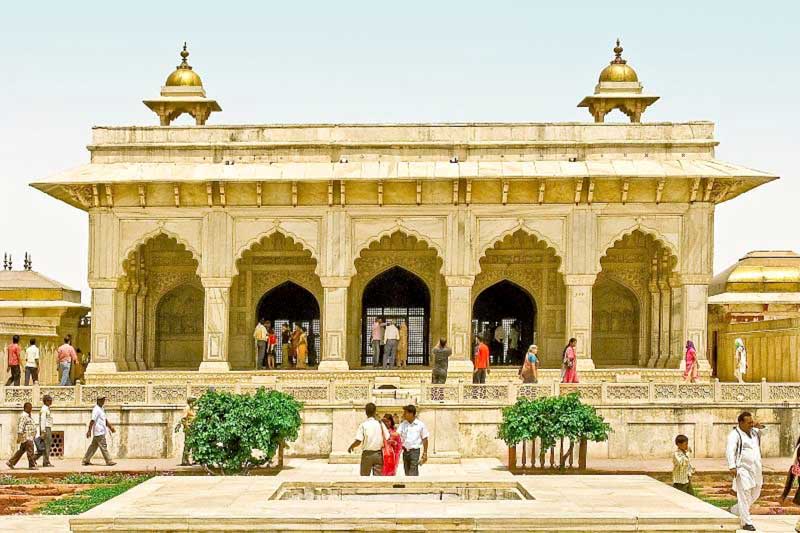
Sprawling over a vast area of 254.67 acres (approx10, 30,612.93 sq m), enclosed by 2.41 kilometres (1.5 miles) of massive walls, accentuated by turrets and bastions that vary in height from 59 feet (18 m) along the side of River Yamuna to 108 feet (33 m) on the city side, the Red Fort, locally known as Lal Qila, a part of the medieval city of Shahjahanabad, represents the peak in Mughal architecture and fascinates travellers all year along. As the fort majestically stands along the bank of the Yamuna, the water of the river feds its moats, which surround most of its outer walls.
Originally known as Qila-I-Mubārak or the Blessed Fort as the residence of the imperial family, it popularly came to be known as Lal Qila, deriving from its red sandstone walls. However, unlike other Mughal forts, the boundary walls of the fort are asymmetrical to contain the older Shalimgarh Fort and thus making the fort octagonal in shape with the north-south axis longer than the east-west axis. The fort was commissioned by the Mughal Emperor Shah Jahan in 1638, when he decided to shift his capital from Agra to the newly constructed city of Shahjahanabad, today known as Old Delhi. Designed by Ustad Ahmad Lahori, the chief Mughal architect during that time, who later created the famous Taj Mahal, construction of the fort began in the sacred Islamic month of Muharram on 13 May 1638, under the personal supervision of Shah Jahan and it took nearly ten years to complete in on 6 April 1648.

Although the fort was the seat of Mughal Emperors for around 200 years, with the decline of the administrative and fiscal structure of the Mughal dynasty after Aurangzeb, condition of the palaces located within the fort boundary started to degenerate during the 18th century.
Apart from that, with the weakness of the rulers, the fort became vulnerable to foreign attacks and was invaded several times between 1739 and 1857. Nadir Shsh, one of the most powerful rulers in Iranian history, invaded and defeated the huge Mughal army in 1739 and returned to Persia after three months, after plundering the city and the fort, along with the famous jeweled Peacock Throne and leaving a destroyed city and a weakened Mughal empire to Muhammad Shah.

In the year 1752, the Mughals became only titular rulers of Delhi as they signed a treaty with the Marathas, who became the protectors of the fort. However, Marathas attacked and conquered Lahore and Peshawar, leading to a conflict with Ahmad Shah Abdali, also known as Ahmad Shah Durrani. To raise money for the protection of the fort against a possible attack by him, the Marathas melted the silver of the ceiling of the Diwan-i-Khas constructed by Shah Jahan, but was defeated by Ahmad Shah in the Third Battle of Panipat in 1761. Ten years later, the Marathas recaptured Delhi from the Rohilla Afghans and reinstated the exiled Emperor Shah Alam, the seventeenth Mughal Emperor, in 1771. After that, Sikhs conquered Delhi and the Red Fort in 1783, but after negotiation, they agreed to leave Delhi and reinstate Shah Alam on conditions, which included the construction of seven Sikh Gurudwaras in Delhi.

After the end of the uprising against the British in 1857, the British captured and sacked the Red Fort, while the last Mughal emperor, Bahadur Shah II, was exiled to Rangoon. The British Colonial Rulers also plundered a lot of precious artifacts from the fort, which included the Kohinoor diamond, the Jade Wine Cup of Shah Jahan and the crown of Bahadur Shah II, before a systematic destruction of the Fort, which included the demolition of the stone screen that connected the pavilions along the fort’s river-facing façade, the Harem apartments servants' quarters and gardens, leaving only the marble buildings on the east side at the imperial enclosure.

Reflecting an artistic synthesis of Indian, Persian and Timurid forms of architecture, the Red Fort is equipped with several gates, which include the two main gates, Lahori Gate on the west and Delhi Gate on the south. Apart from the Khizrabad Gate, reserved only for the emperor, the other gates of the fort are Ajmeri Gate, Kashmiri Gate, Mori Gate and Turkman Gate. The Lahori Gate, named for its orientation towards the city of Lahore and serving as the main entrance, leads to a domed shopping area known as the Chatta Chowk, a covered bazaar, which in turn leads to the Naubat or Naqqar-Khana or Drum-house, serving as the entrance to the Diwan-i-Aam, where ceremonial music was played at scheduled times and everyone, except royalty, were required to dismount. The Diwan-i-Aam, which served as the Hall of Public Audience is a large rectangular hall with a façade of nine arches consisting of three aisles. The royal throne stood in an alcove at the rear of the hall under a marble canopy. The wall behind the throne is ornamented with beautiful panels of artistic work depicting Orpheus, said to have been executed by a Florentine artist, Austin de Bordeaux.

Apart from the above, the huge complex of the fort contains several other beautiful structures which include Diwan-i-Khas, Mumtaz Mahal, Rang Mahal, Khas Mahal, Hammam and Moti Masjit. A gate on the north side of the Diwan-i-Aam leads to Diwan-i-Khas or Hall of Private Audience, constructed of white marble and lavishly inlaid with precious stones. The hall, equipped with ornamented pillars, has a flat ceiling, supported on engrailed arches. The lower portions of its pillars are ornamented with floral panels, while the upper portions were originally gilded and painted. The marble platform in the hall is said to have supported the famous Peacock Throne, which was looted away by the Persian invader Nadir Shah.

The extreme southern part of the fort contains the Zenana Mahal or women’s quarters, consisting of Mumtaz Mahal, especially built for Arjumand Banu Begum, popularly known as Mumtaz Mahal, wife of the Mughal emperor Shah Jahan and the comparatively larger, brightly painted and Rang Mahal, meant for the use of the other wives and mistresses of the emperor. A water-channel, known as the Nahr-i-Bihisht or the Stream of Paradise, which used to draw water of the river Yamuna from the Shahi Burj, located at the north-eastern corner of the fort, runs through the centre of each pavilion and also feds the marble pool of the Zenana Mahal, adorned with an ivory fountain. Today, the Mumtaz Mahal houses a museum, called the Red Fort Archaeological Museum. The Khas Mahal, the emperor's apartment, is connected to the octagonal Muthamman-Burj, from where the emperor appeared before his subjects every morning. In 1808, Emperor Akbar added a small balcony, projected from the Burj, from where King George V and Queen Mary appeared before the people of Delhi in December 1911.

Another interesting feature of the Red Fort is its Hammam or Bath, consisting of three rooms crowned with domes and white marble patterned floors, separated by corridors. The rooms were illuminated with the help of a coloured skylight. While the two rooms, located on either side of the present entrance were probably used by the royal children for bathing, the eastern apartment, containing three fountain basins, was possibly used primarily as a dressing room. Each room contained a fountain in the centre, although one of the rooms contained a marble reservoir built into the floor. It is said that one of the fountains in the easternmost apartment used to emit rose water. All the baths were provided with hot and cold water and the western apartment, equipped with heating arrangement fixed in its western wall, was used for hot or vapor baths.

Moti-Masjid or Pearl Mosque, a small, three-domed mosque carved in white marble, equipped with a three-arched screen leading down to the courtyard and located to the west of the Hammam, was built in 1659 by Emperor Aurangzeb as a private mosque. The Hayat-Bakhsh-Bagh, which means the Life-giving garden, is located to the north of the Moti mosque, with a white marble pavilion at each end, called the Sawan and Bhadon Pavilions, is located to the north of the Moti mosque. It also features a reservoir and a red-stone pavilion in the middle of the tank, which was constructed by Bahadur Shah II, in about 1842 and is called Zafar-Mahal.

Reckoned as a UNESCO world heritage site in 2007, Red Fort is the largest monument and one of the most popular tourist attractions in Delhi. It is also regarded as a monument of national significance, because on 15 August 1947, Mr Jawaharlal Nehru, the first Prime Minister of Independent India hoisted the Indian flag above its Lahori Gate.